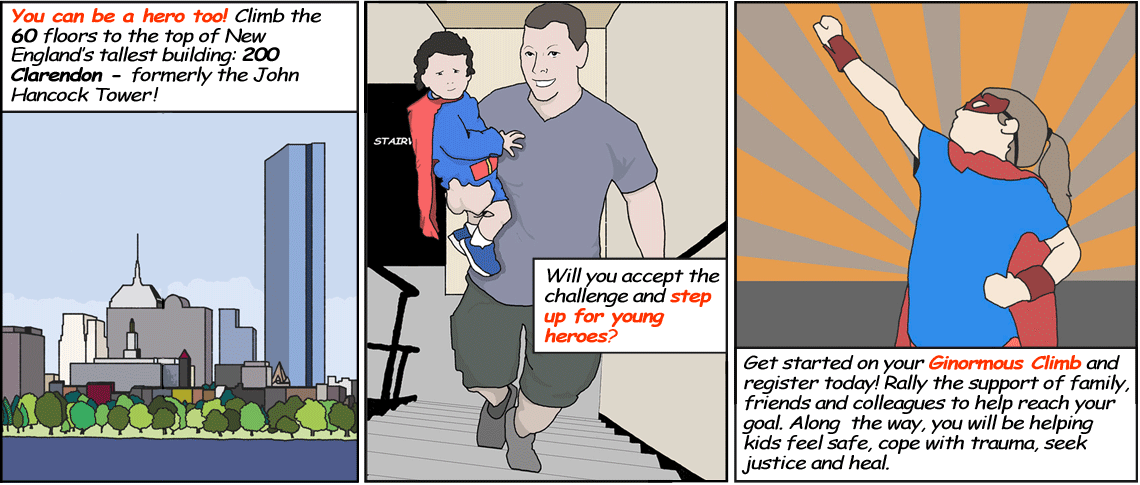
Training Tips
A stairclimb is a great athletic challenge for all fitness levels! You do not need to be a marathon runner or even a regular gym goer to complete a stair climb. You should prepare as you would if you were walking or running in a 5K race – although the climb will take less time than a 5K (most people complete a 60 floor stair climb in 20 minutes).
The best training is to start incorporating climbing into your weekly routine. You should aim to be comfortable with 15-20 minutes of climbing a few times a week prior to the climb. For your own safety, consult your doctor before training. Also, be sure to wear appropriate footwear (bring sneakers to work if you plan to tackle the stairs to and from your office) and pace yourself. A common mistake in stair climbing is ascending too fast. To avoid lightheadedness or leg cramping, take your time and stay relaxed. No matter how fast or slow you climb, reaching the top is a huge accomplishment and feels great!
Here are some additional training tips to make you feel even more prepared for a stair climb:
Step 1
Acclimate your body to moving vertical by taking the stairs whenever possible throughout your day. Even one or two flights can help with conditioning and muscle memory. Skip the elevator at work, the department store or your apartment building and opt for the stairs instead.
Step 2
Increase the amount of stairs that your climb during your training sessions gradually. Injuries often take place when people become over-ambitious in their training and attempt too much too soon. Include stair climbing sessions in with other types of cardio activity, for example, jog for 10 minutes, climb stairs for five, jog for another 10 and finish with another five-minute stair session. Gradually increase the amount of time that you are on the stairs.
Step 3
Climb a large number of stairs at a slower pace. Train on bleachers or a tall building that allows you to continually climb stairs for 15, 20 or 30 minutes, depending on your ability. Keep the pace moderate, as the point is to increase your endurance. Pick your pace up over time.
Step 4
Spring up a flight of stairs, taking the stairs two at a time, then recover for 30 to 60 seconds by walking. Complete 10 to 15 repetitions, shortening your recovery time as you become stronger.
Step 5
Incorporate other training exercises to increase the strength in your legs two to three times per week. Examples include squats, lunges and jumping rope, all of which have a vertical element to them and are effective at creating power from the waist down.
Source: www.livestrong.com
Fundraising Tips
GET THE BALL ROLLING
Nobody likes to be first. That’s why it’s always a good idea to get your fundraising off to a good start by making the first contribution. This will make others more likely to get involved.
ADD YOUR WHY TO THE EMAIL
We’ve put together an email template you can use right from your fundraising page. The most important thing you can add to this message is why you are fundraising. Let your family and friends know why this matters to you, that’s what they care about most!
START WITH YOUR CLOSE CONTACTS
It’s always best to start by emailing your close contacts because they are the most likely to donate. Try sending some quick personal messages to your inner circle to build up some momentum. Then use the email template you customized to reach all of your other contacts.
NOW MOVE TO SOCIAL MEDIA
Once you’ve sent your first batch of emails out, it’s time to turn to social media.
One of the best strategies to use on both Facebook and Twitter is tagging and thanking people that have already donated while you are asking for new donations. This spreads your message further and lets the people you are asking know that people are already getting behind you.
Fundraising often takes a little creativity and persistence, but it’s vitally important to our mission and you can do it. Know that your effort will make a big difference! THANK YOU!
We're here to help! Check out more fundraising ideas here or contact us at 617.779.2146 or info@suffolkcac.org to help you get the ball rolling!
